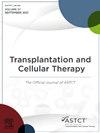Two Nonmyeloablative HLA-Matched Related Donor Allogeneic Hematopoietic Cell Transplantation Regimens in Patients with Severe Sickle Cell Disease
IF 3.6
3区 医学
Q2 HEMATOLOGY
引用次数: 0
Abstract
Nonmyeloablative (NMA) conditioning is being used increasingly with success in matched related donor (MRD) and alternative donor allogeneic hematopoietic cell transplantation (allo-HCT) in individuals with sickle cell disease (SCD). Advantages include decrease toxicity and applicability in patients otherwise unable to tolerate conditioning regimens due to end-organ damage or age. We aimed to add to published data outcomes of two similar NMA conditioning protocols, termed Protocol 1 (ClinicalTrials.gov ID NCT00061568) and Protocol 2 (ClinicalTrials.gov ID: NCT02105766)) in mainly adult patients with SCD to evaluate the safety, toxicity, and success of these regimens in individuals at high-risk for poor transplantation-related outcomes. We also evaluated the tolerability and outcomes of Protocol 2, which included preconditioning immunodepletion, in patients at even higher risk of T cell-mediated rejection or plasma/B cell-mediated anti-donor erythrocyte antibody production—the latter due to ABO incompatibility or recipient RBC alloimmunization to a donor antigen. Finally, we evaluated the incidence and trajectory of mixed donor myeloid chimerism over time following allo-HCT. In this retrospective analysis of the 2 prospective phase 2 NMA transplant protocols, 91 individuals with SCD or transfusion-dependent β-thalassemia underwent MRD allo-HCT at the National Heart, Lung, and Blood Institute; regimens contained alemtuzumab, low-dose radiation, and sirolimus for graft-versus-host disease (GVHD) prophylaxis with or without preconditioning immunodepletion with pentostatin and oral cyclophosphamide (Protocol 2). In the total cohort of 91 transplantation recipients, outcomes were favorable with timely neutrophil and platelet engraftment (median, 21 days [range, 7 to 67 days] and 21 days [range, 10 to 112 days], respectively), minimal high-grade acute GVHD and no chronic GVHD, overall survival of 90%, sickle-free survival of 85%, and mixed donor myeloid chimerism in 43% at a median follow up of 7.3 years (range, 0.8 to 20 years). Most patients with mixed myeloid chimerism at 2-years post-HCT remained stable in their values. In analyzing each protocol separately, outcomes were comparable except for higher cytomegalovirus reactivation necessitating treatment in Protocol 2 without an associated increase in graft failure. In the combined cohort, graft failure occurred in 11 patients, and hematologic malignancy or abnormal cytogenetics on bone marrow evaluation developed in 7 patients. In a subanalysis of factors that may implicate transplantation outcomes, the number of RBC units transfused post-HCT was significantly higher in recipients with pre-HCT history of alloimmunization to donor RBC antigens. There was no difference in the number of RBC units transfused, duration of transfusion, or red cell engraftment in those with major ABO incompatibility; preconditioning immunodepletion and pretreatment with rituximab likely were helpful. Both NMA allo-HCT protocols were successful in achieving adequate engraftment and sickle-free survival with minimal toxicity, including in individuals with mixed donor myeloid chimerism. The addition of preconditioning immunodepletion was well-tolerated and reduced the rate of graft failure in high-risk recipients.
两种非清髓性hla匹配相关供体异体造血细胞移植方案在严重镰状细胞病患者中的应用
背景:非清髓(NMA)调节越来越多地用于匹配相关供体(MRD)和替代供体异体造血细胞移植(alloo - hct)治疗镰状细胞病(SCD)。优点包括毒性降低,适用于因终端器官损伤或年龄而无法耐受调节方案的患者。目的:我们旨在将两种类似的NMA方案“方案1”(clinicaltrials.gov ID: NCT00061568)和“方案2”(clinicaltrials.gov ID: NCT02105766)的已发表数据结果添加到主要针对成年SCD患者的NMA方案中,以评估这些方案在移植相关预后不良的高风险个体中的安全性、毒性和成功。我们还评估了方案2的耐受性和结果,其中包括预处理免疫消耗,在t细胞介导的排斥反应或血浆/ b细胞介导的抗供体红细胞抗体产生的风险更高的患者中,后者是由于ABO不相容或受体红细胞对供体抗原的同种免疫。最后,我们评估了同种异体造血干细胞移植后混合供体骨髓嵌合的发生率和发展轨迹。研究设计:在这两项前瞻性2期NMA移植方案的回顾性分析中,91名SCD或输血依赖性地中海贫血患者在国家心肺血液研究所接受了MRD异体hct检查;方案包括阿仑单抗、低剂量辐射和西罗莫司预防移植物抗宿主病(GVHD),伴或不伴戊他汀和口服环磷酰胺预处理免疫消耗(方案2)。结果:在91名移植受者的总队列中,及时植入中性粒细胞和血小板的结果是有利的(中位:21天(范围,7-67)和21天(10-112),轻度急性和无慢性GVHD,总生存率为90%,无镰状细胞生存率为85%,混合供体骨髓嵌合率为43%,中位随访7.3年(范围,0.8-20)。大多数混合髓系嵌合患者在hct后2年的数值保持稳定。在单独分析每个方案时,结果是相似的,除了方案2中需要治疗的巨细胞病毒再激活更高,没有相关的移植物失败增加。在联合队列中,11例患者发生移植失败,7例受者出现血液恶性肿瘤或骨髓评估异常细胞遗传学。在可能影响移植结果的因素亚分析中,hct后输血的红细胞单位数明显高于hct前对供体红细胞抗原有同种免疫史的受者。在输血的红细胞单位、输血时间和红细胞植入方面,ABO血型严重不相容的患者没有差异;预处理免疫消耗和利妥昔单抗预处理可能有帮助。结论:两种NMA同种异体hct方案都成功地实现了充分的植入和无镰状细胞生存,毒性最小,包括混合供体骨髓嵌合的个体。在高风险受者中,预适应免疫消耗的加入耐受性良好,并降低了移植物失败率。
本文章由计算机程序翻译,如有差异,请以英文原文为准。
求助全文
约1分钟内获得全文
求助全文
来源期刊

Transplantation and Cellular Therapy
Medicine-Hematology
CiteScore
7.00
自引率
15.60%
发文量
1061
审稿时长
51 days
 求助内容:
求助内容: 应助结果提醒方式:
应助结果提醒方式:


